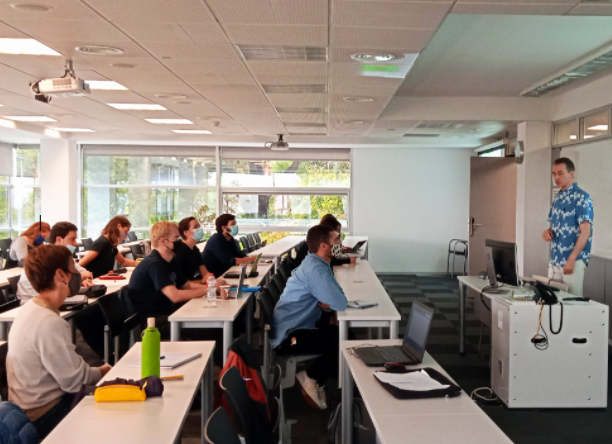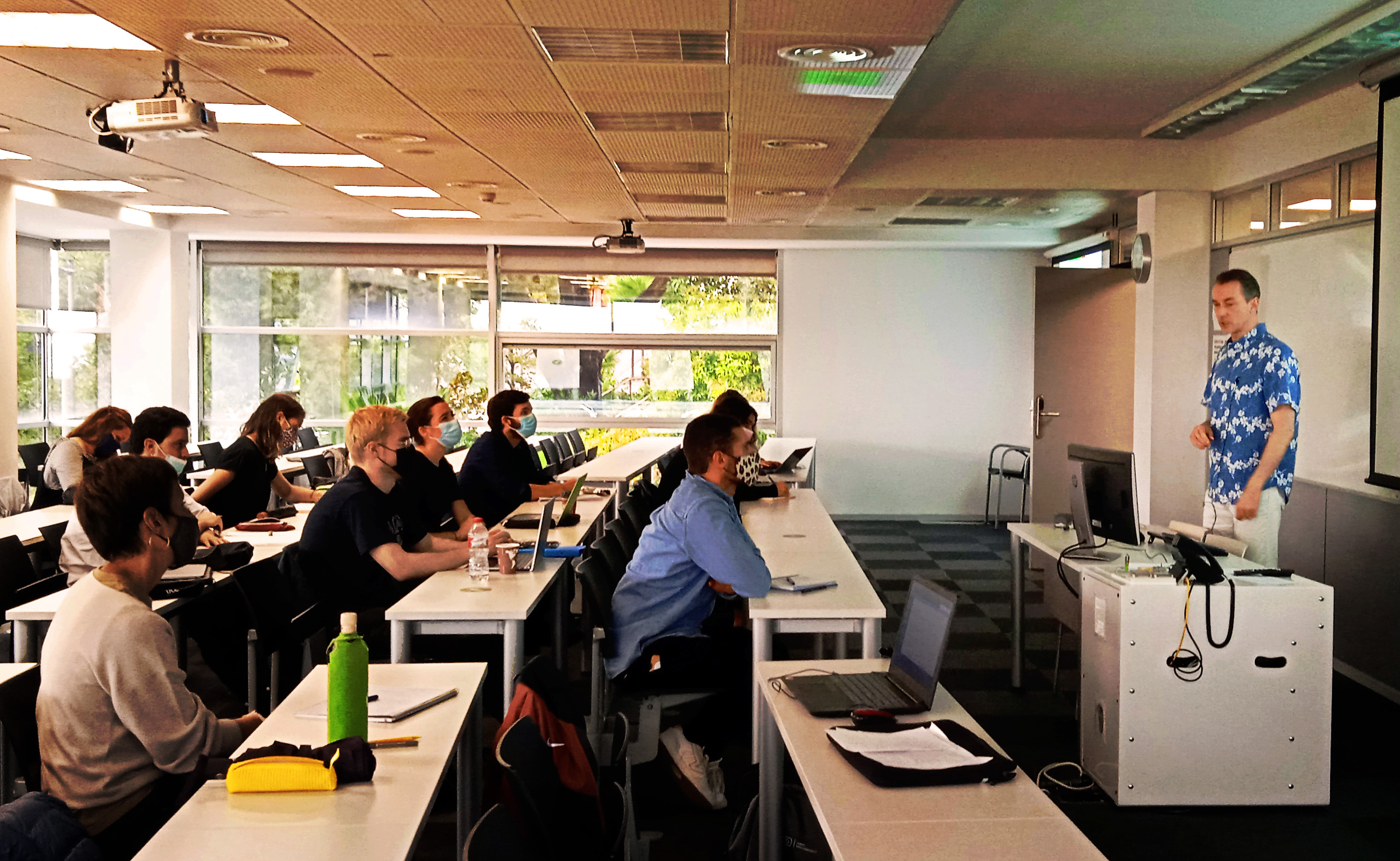
Professor Marc Wolfram opening the debate with the students
On our opening day of the Masters of City Resilience Design and Management we invited Professor Marc fram (director of the Leibniz Institute of Ecological Urban and Regional Development) to deliver a keynote speech linking resilience to nowadays urban planetary challenges. Drawing on his current role with the Leibniz Institute, his role of editor of the international Jouurnal Urban Transformatios, and his long research career in Seoul, Mark explored the theme of transformative capacity and resilience through the lens of SeouLab (an Energy Transition Living Lab and place-based solutions for socio-technical transformation to trial, test and redefine the urban system)
Particular interest was placed in how, to date, responses to planetary challenges explore the transformation of urban systems through decarbonisation, digitisation, natural hazard risk reduction, and more recently, changes to urban organisation and economic systems driven by the Covid-19 pandemic. Responses can see innovation, breakthroughs and be a stabilising force, driven by ecological and technical solutions. However, the path to resilience and transformation creates winners and losers, highlighting the inequalities in our systems. Inequality and exclusion are innate to our socio-economic and political systems, and are therefore reintroduced to the transformed systems. A good approach to fight those inequalities may lie in feeding the paradigm of place-based approaches, and social learning to empower communities to define a just urban transition.

Key points for understanding the framing of urban Resilience and just Transformations:
In science and policy, urban resilience is seen as a good and coherent concept that will enable places to cope with hazards and guarantee the less disruption possible (metaphorically referred as “bounce back” to previous conditions). Yet urban resilience is something definitely more complex and nuanced than this (as explored in different posts of the Urban Resilience Network – here one from Prof. Simin Davoudi et al). Because urban systems are inherently complex, and hard to define, the contextual boundaries of urban resilience are fuzzy too, simplistic positive metaphorical meanings of resilience need to be unpacked, to deeply understand what’s behind the metaphor of resilience, when addressing cities. Here 3 main assumptions exploring why resilience needs to be linked to sustainability and just transformations.
1) Urban resilience is not always desirable nor sustainable thing
Adaptive capacities are addressing different threats across multiple scales, through different approaches and actions. The general assumption is that outcomes are leading to improved conditions with respect to the pre-existing vulnerable ones. Yet, as highlighted in many recent papers, sometimes policies addressing resilience tend to favor a “conservative pathway”, reinforcing the (unfortunately un-sustainable) status quo of our cities and societies, living within risks, and addressing through resilience the consequences rather than fight the causes of our vulnerabilities. The problem with this is that nowadays pathways are quite un-sustainable (and increasing favoring inequalities). Thus not always resilience helps in moving toward a transformative sustainable pattern.
In the figure below you can clearly see this, with unsustainable patterns which need to be destabilized and dismantled, which sustainable ones need to be reinforced and accelerated.

Both patthers of developme could be resilient ! This is why we need to be critic with respect to resilience, and understand which patters and developments’ resilience need to be decreased, in order to leave behind those unsustainable patterns, and which ones’ resilience need to be fostered.
2) “Urban” Resilience can be conceptually fuzzy and Incoherent
The term resilience has been subject to debate on what it actually means, especially when referring to cities and urban systems. Urban systems are inherently complex, adaptive and interconnected, and thus hard to categorize or define. There have been many scholarly articles asking what is urban in urban resilience, and examining resilience for who, what, where, when and why. Trying to work with resilience – which meaning is already vague and metaphorical – looking at complex systems like cities and regions can lead to incoherences respect to how practices and implementations reflects definitions. So, what if instead of trying to define resilience within a rigid framework of criteria we used a more generalized idea of how to achieve resilience in a constantly changing system?
Changes and resilience at one singular scale or system does not contribute to the resilience of the whole system per se, as there are always unintended or unexpected trade-offs, both at spatial and temporal scales. “Transformation” could help here. Resilience and transformative capacities are not mutually exclusive. Building transformative capacity of the whole system could the bridge between theoretical and practical perspectives of resilience.
3) Urban Resilience should Mean Bouncing Forward through transformative change
If we wish to have clear understanding – and coherence in the implementation – of what urban resilience means, it is crucial to make a fundamental clarification between the meaning of the resilience approaches of ‘bouncing back’ or building transformative capacity to ‘bouncing forward’. This distinction is crucial for reinforcing a just-transition approach that breaks down unequal systems that govern urban systems.
‘Bouncing back’ to outdated ways of thinking and operating hinder the urgent need for cities to evolve and innovate in the face of environmental and social destruction. Cities ability to ‘bounce forward’ lies in transformative capacity that enables space for change. However, transformative capacity can only be supported by transformative leadership and multiform governance, two of Marc Wolframs’ key components in the ‘10 Key components of Transformative Capacity’. Disruptions to the system, from a pandemic or a flood, highlights inefficiency in an urban system. Bouncing back to the status quo subjects urban areas to the same vulnerabilities that disrupted the system. Bouncing forward in the wake of disaster allows cities to rebuild from the rubble (metaphorical or literal rubble) new systems, places and infrastructures that are better, more inclusive and subsequently more resilient.
Key take-home message: linking resilience, transformation and communities
The Anthropocene has been an era of innovation and change, bringing incredible technological and economic growth. However, most of the time these innovations lead to unsustainable and inequitable patterns of development. Humanity must now invest in a paradigm shift. It is no longer a case of ‘winners and losers’ within a system. The fight against climate change and its effects is a case of winner takes all. As we head the task of transforming complex urban systems, it is essential for resilience to be a sustainable and equitable reinforcing attribute of our strategies, driven by a bouncing forward approach while breaking down the resiliency of systems that are no longer beneficial or sustainable. As was shown in the figure above, transformation is indeed requiring the destabilisation of the existing unsustainable state, dismantling the power dynamics that impede a socially just-transition. This is a complicated and messy process but there is no other option. Business-as-usual is no longer an option. Resilience is about social learning, innovation for sustainability, community and place making.
How to do it ?
In September, the Leibniz Institute of Ecological Urban and Regional Development (IOER) hosted the Annual Conference “Space & Transformation”, looking at how to learn and leverage from one another to ensure a transformation is a force for good. Social learning and building social capital will define the transformative capacity of urban environments and enhance urban resilience, insofar as governance and relational dimensions co-design and co-deliver resilience outcomes.
However, we all know the socio-economic systems are built to preserve the power of the few, and transformation often means the dissemination of that power. Marc close its keynote inviting us again to take a deeper look at the SeouLab, referring to it as a platform that removed institutional barriers between governance bodies and communities, allowing successful energy transition across scales.
by Allison Ahern and Marli Roberts
Further readings:
- Assessing transformative capacity for sustainable urban regeneration: A comparative study of three South Korean cities
- Deconstructing Smart Cities: An Intertextual Reading of Concepts and Practices for Integrated Urban and ICT Development
- Cities shaping grassroots niches for sustainability transitions: Conceptual reflections and an exploratory case study
- Urban Planning and Transition Management: Rationalities, Instruments and Dialectics
- Learning in urban climate governance: concepts, key issues and challenges
- Urban transformative capacity: From concept to practice
- Learning urban energy governance for system innovation: an assessment of transformative capacity development in three South Korean cities
- Grassroots Niches in Urban Contexts: Exploring Governance Innovations for Sustainable Development in Seoul
- Grassroots Niches in Urban Contexts: Exploring Governance Innovations for Sustainable Development in Seoul


